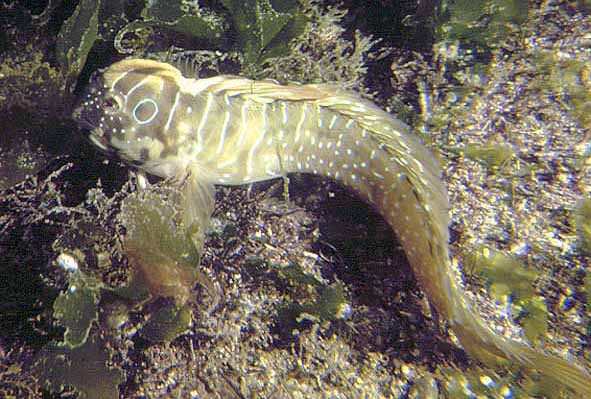| Blenniidae (Combtooth blennies), subfamily: Salariinae |
| 13.8 cm TL (male/unsexed) |
|
demersal; brackish; marine |
| Eastern Atlantic: Atlantic coast from France to Morocco; also in the Mediterranean and Black seas and in the Suez Canal. |
|
Dorsal spines (total): 11-13; Dorsal soft rays (total): 22-25; Anal spines: 2-2; Anal soft rays: 23-26. Diagnosis: Mature males with well-developed head-crest and anal gland in the first two anal-fin rays; sneaker males much smaller than nesting males and do not display male secondary sexual characters (Ref. 94108). Description: Dorsal fin with 11-13 spines and 22-25 soft rays; anal fin with 2 spines and 23-26 soft rays; pectoral fin with 14 rays; pelvic fin with 1 spine and 3 soft rays (Ref. 128181). |
| Adults occur in the intertidal zone and shallow bottoms, on rocks or sand between pebbles and vegetation (Ref. 5981). Often in brackish waters down to 5 ppt (Ref. 5981). Inhabit crevices or piddock holes, males remain in cavities above water-level during low tide (Ref. 5981). Feed on benthic invertebrates, mainly mollusks, also algae (Ref. 5981). Also ingest large amounts of aquatic insects and pupae (Ref. 94105). Oviparous (Ref. 205). Mature males adopt a passive role during courtship, rarely court females, do not defend nest territory, but provide parental care to eggs. Sneaker males assume a female-like behavior in order to approach the nests of nesting males and parasitically fertilize the eggs (Ref. 94113). Eggs are demersal and adhesive (Ref. 205). Has been reared in captivity (Ref. 35421). |
|
Least Concern (LC); Date assessed: 14 November 2007 Ref. (130435)
|
| harmless |
Source and more info: www.fishbase.org. For personal, classroom, and other internal use only. Not for publication.

